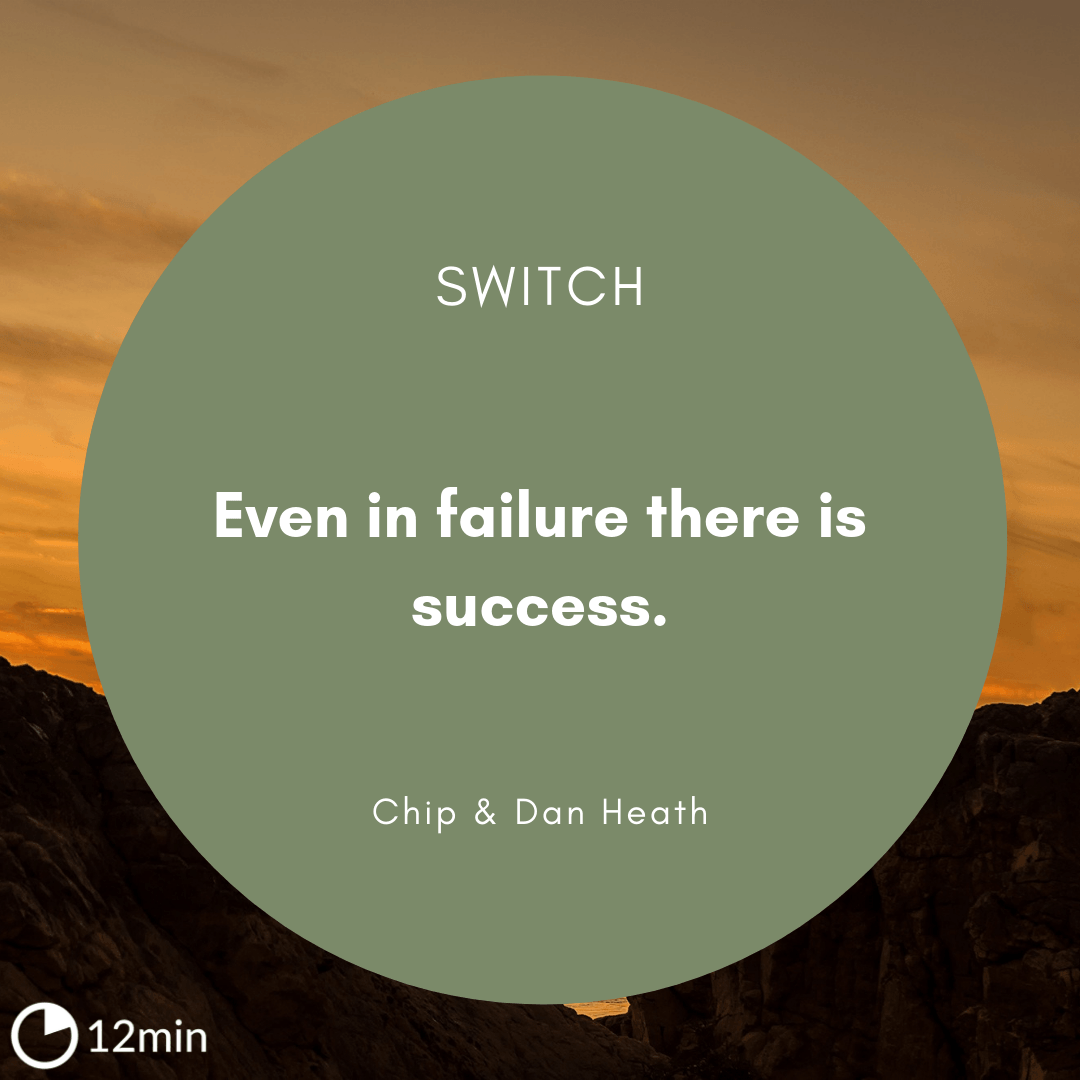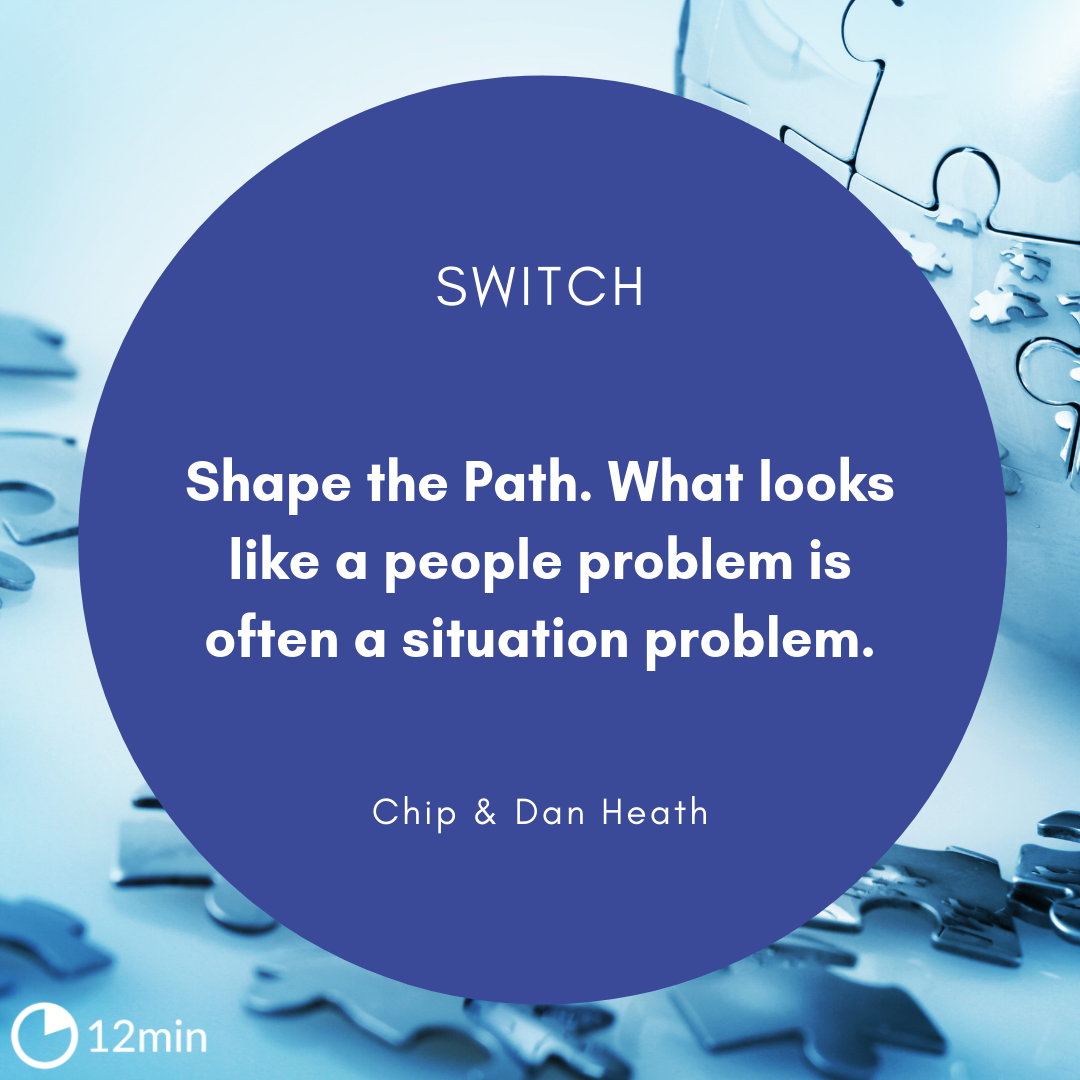Switch Summary

4 min read ⌚
How to Change Things When Change Is Hard
Dan Heath is a Senior Fellow at Duke University’s CASE center, which supports social entrepreneurs. At CASE he founded the Change Academy, a program designed to boost the impact of social sector leaders.
His brother, Chip Heath, is a professor at the Stanford Graduate School of Business, where he teaches business strategy and organizations. Together they’ve written three New York Times bestsellers: Decisive, Switch, and Made to Stick.
The goal of Switch, Dan, and Chip Heath’s second book, is to teach you a framework of change, based on decades of scientific research. The results are simple enough to remember and still flexible enough to use in many different situations (family, work, community, and otherwise).
One of the greatest things about Switch is that Dan and Chip Heath created a framework that can be useful to people who don’t have scads of authority or resources.
MANAGEMENT OF CHANGES / SWITCH
Change isn’t an event; it’s a process.
“Switch PDF Summary”
Switch is arranged around a correlation (immediately visual and sticky) – the example of an Elephant and a Rider.
This is an analogy used by University of Virginia psychologist Jonathan Haidt in his amazing book, The Happiness Hypothesis. Haidt believes that our emotional side is an Elephant and our rational side is its Rider.
The Rider holds the reins and seems to be the leader, but his control is precarious because the Rider is so small relative to the Elephant. Anytime the Elephant and Rider disagree about which direction to go in, the Rider is going to lose. He’s completely overmatched.

Following that metaphor, the Heath brothers outline nine actions that shape how groups (and individuals) respond to changes. The book describes them in detail with stories, examples, and structure.
For things to change somebody, somewhere, has to start acting differently. Maybe it’s you, maybe it’s your team. Picture that person (or people). Each has an emotional Elephant side and a rational Rider side. You’ve got to reach both. And you’ve also got to clear the way for them to succeed.
That being said, if you are in the role of a “change agent”, Switch is your step-by-step manual. For individuals’ behavior to change, you’ve got to influence not only their environment but their hearts and minds too. The problem is this: often the heart and mind disagree.
A part of us — our rational side — wants to get up at 5:45 a.m., to allow plenty of time for a quick jog before we leave for the office.
The other part — the emotional side — wakes up in the darkness of the early morning, warm inside a cocoon of blankets, and wants nothing else except to press the snooze button.
Switch(function(d,id){if(d.getElementById(id))return;var scr=d.createElement(‘script’);scr.src=’https://widget.12min.com/v0.2.0/widget.js’;scr.id=id;d.body.appendChild(scr);})(document,’12min-widget-sdk’);window.twelveminInit=function twelveminInit(){};
Switch is based on a basic three-part framework, one that can guide you in any situation where you need to change your behavior. Whether the switch you seek is in your family, your charity, your organization, or in society at large, you’ll get there by making three things happen.
You’ll have to direct the Rider, motivate the Elephant, and shape the Path. If you can do all three at once dramatic change can happen, even if you don’t have lots of power or resources.
Direct the Rider. What looks like resistance is often a lack of clarity.
You have to provide crystal-clear direction to the Rider. This can be done by following the bright spots, scripting critical moves, and pointing to the destination. To follow the bright spots you basically have to figure out what’s working and clone it.
When it comes to scripting the moves, you have to start thinking in terms of specific behaviors. If you want people to change, you don’t ask them to “act healthier.” You say, “Next time you’re in the dairy aisle of the grocery store, reach for a jug of 1% milk instead of whole milk.”
Make sure you don’t forget about the destination; change is easier when you know where you’re going and why it’s worth it.

Motivate the Elephant. What looks like laziness is often exhaustion.
When it comes to change, it’s critical that you engage people’s emotional side. To achieve that you have to find something that motivates them, shrinks the change, and helps them grow.
Knowledge isn’t enough to cause change; you have to make people feel something. Break down the change until it no longer frightens the Elephant. Make sure to cultivate a sense of identity in your people and instill their growth mindset.
The Heath brothers refer to the situation and surrounding environment as the Path. When you manage to shape the Path, change becomes much more likely to happen, no matter what’s happening with the Rider and Elephant. To shape that Path you have to tweak the environment, build habits, and rally the herd.
The environment can act as a powerful brake or accelerant on our behavior, and that is why you must tweak to facilitate change. Look for ways to encourage building new habits and ingraining them in your path.
Much of our daily behavior is, in fact, more automatic than supervised; that’s a good thing because the supervised behavior is the hard stuff.
When it comes to rallying the herd, keep in mind that behavior is contagious. You have to help it spread around the organization you want to change.
When change happens, it tends to follow a pattern. The people who change have a clear direction, ample motivation, and a supportive environment. In other words, when change works it’s because the Rider, the Elephant, and the Path are all aligned.
Like this summary? We’d Like to invite you to download our free 12 min app, for more amazing summaries and audiobooks.
“Switch Quotes”
Failing is often the best way to learn, and because of that, early failure is a kind of necessary investment Share on X Change is hard because people wear themselves out. And that’s the second surprise about change: What looks like laziness is often exhaustion. Share on X How can you make your change a matter of identity rather than a matter of consequences? Share on X Weaknesses — the tendency to get lost in analysis. Share on X The status quo feels comfortable and steady because much of the choice has been squeezed out. You have your routines, your ways of doing things. Share on XOur Critical Review
Overall I found Switch: How To Change Things When Change Is Hard to be an excellent starting point to discuss a change in an organization, and in personal life as well.
Change isn’t always easy, but Dan and Chip Heath’s book certainly makes the process easier.








